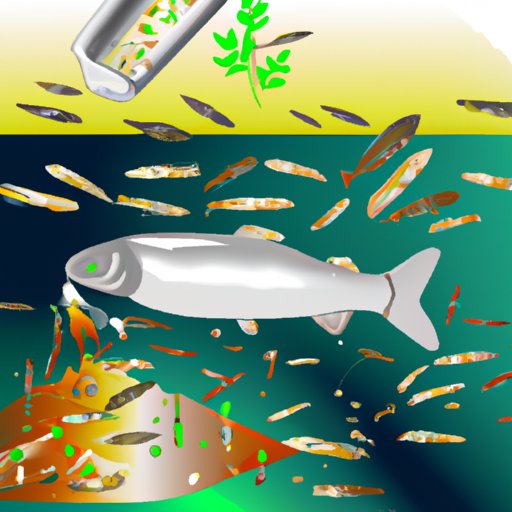Introduction
Mercury is a toxic metal that can have serious environmental and health impacts when it accumulates in the food chain. It is a major pollutant found in aquatic environments, and it can enter the food chain through various pathways. This article will explore how mercury gets into fish, its effects on fish populations, the sources of mercury contamination, the role of bioaccumulation and biomagnification, the impact of human activities on mercury levels, and the health risks associated with eating contaminated fish.

Analyzing the Effects of Mercury Pollution on Fish Populations
Mercury has been found to have detrimental effects on fish populations. According to a study by the National Oceanic and Atmospheric Administration (NOAA), “exposure to methylmercury can cause reproductive failure, reduced growth and survival rates, altered behavior, and other adverse effects in fish.” It is especially dangerous to fish during their early stages of development, as exposure to the toxin can cause deformities and reduce survival rates. Mercury can also affect fish behavior, making them more susceptible to predation.

Exploring the Sources of Mercury Contamination in Aquatic Environments
Mercury can enter aquatic environments from both natural and anthropogenic sources. Natural sources of mercury include volcanic eruptions and weathering of rocks and soil. Anthropogenic sources of mercury include industrial emissions, agricultural runoff, and domestic waste. The burning of coal is one of the most significant sources of mercury pollution, as coal-fired power plants release large amounts of mercury into the atmosphere.

Investigating How Mercury is Transported and Accumulates in Fish
Once mercury enters an aquatic environment, it can be transported by water and air. It can then accumulate in fish through a process called bioaccumulation. According to the Environmental Protection Agency (EPA), “bioaccumulation occurs when organisms take in and store contaminants faster than they can eliminate them.” Bioaccumulation can become even more pronounced over time through a process called biomagnification. The EPA states that “biomagnification occurs when organisms at higher trophic levels (i.e., higher up the food chain) accumulate higher concentrations of contaminants than those found in lower trophic levels.” In other words, mercury can accumulate in fish more quickly than it can be eliminated, leading to higher concentrations of mercury in larger, predatory fish.
Examining the Impact of Human Activities on Mercury Levels in Fish
Human activities are responsible for many of the sources of mercury pollution in aquatic environments. Industrial processes, such as mining and smelting, are significant contributors to mercury pollution. Additionally, agricultural runoff from fertilizers and pesticides can contribute to mercury pollution. Finally, domestic waste, such as sewage, can introduce mercury into aquatic environments. Climate change can also play a role in increasing mercury levels in fish, as warmer temperatures can lead to increased evaporation of mercury from the surface of the ocean.
Assessing the Health Risks Associated with Eating Contaminated Fish
The health risks associated with consuming mercury-contaminated fish are well documented. According to the World Health Organization (WHO), “long-term exposure to methylmercury, even at relatively low levels, can cause neurological and developmental problems.” Children and pregnant women are especially vulnerable to the effects of mercury poisoning, as their developing bodies are more sensitive to the toxin. To reduce the risk of ingesting contaminated fish, WHO recommends limiting consumption of large, predatory fish, such as tuna, swordfish, and shark, which tend to have higher concentrations of mercury.
Conclusion
Mercury is a toxic metal that can have serious environmental and health impacts. It enters aquatic environments from both natural and anthropogenic sources and can accumulate in fish through a process called bioaccumulation and biomagnification. Human activities, such as industrial emissions and agricultural runoff, are significant contributors to mercury pollution. Moreover, climate change can increase mercury levels in fish. Eating contaminated fish can have severe health consequences, particularly for children and pregnant women. To reduce the risk of ingesting contaminated fish, it is important to limit consumption of large, predatory fish and to take steps to reduce mercury pollution.
(Note: Is this article not meeting your expectations? Do you have knowledge or insights to share? Unlock new opportunities and expand your reach by joining our authors team. Click Registration to join us and share your expertise with our readers.)
